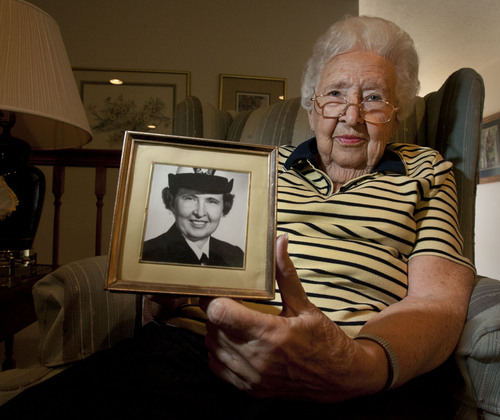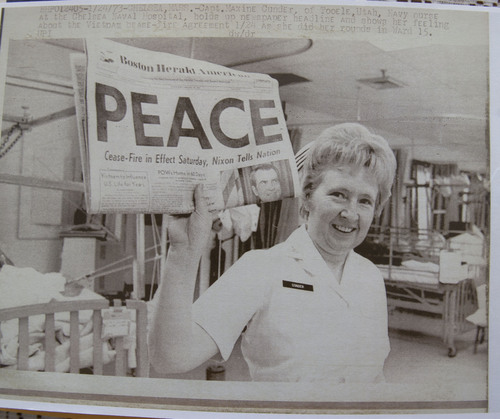This is an archived article that was published on sltrib.com in 2013, and information in the article may be outdated. It is provided only for personal research purposes and may not be reprinted.
In a cacophony of mid-'70s political upheaval, Maxine Conder earned her stripes.
Vietnam had soured the public on the military. Congress was waffling on funding for the armed services. Feminism was redefining the role of women, and not everyone was pleased.
So Conder knew she was about to occupy a very hot seat when she received word in 1975 that she had been appointed the second female admiral in U.S. naval history.
"I was excited and sick to my stomach," Conder said. "While I was honored to be promoted, I knew there would be many, many problems."
Conder is one of 11 veterans to be honored Monday at the University of Utah's 16th annual Veterans Day Commemoration Ceremony. The ceremony begins 11 a.m. at the Olpin Union Building, 200 S. Central Campus Drive.
As director of the Navy Nurse Corps, Conder was in charge of 2,600 nurses stationed across the world — a position that hadn't even been available to a woman when Conder joined the Navy in 1951 as a 25-year-old nurse from Tooele, deployed to a hospital ship in Korea. At the time, women could not ascend the command structure of any military branch. Now 87, Conder cannot deny her role as a waymaker for women in the military.
"I'll admit I'm proud of that," she said reluctantly.
But she reflects on her 28-year career not as a loud feminist statement, but simply a good professional fit.
"I truly liked nursing, and I truly liked the Navy," Conder said. "I always seemed to be in the right place at the right time. ... I've never even had a bad duty station. It was either the people were so special, or the place was so special. I think I enjoyed each and every one of them."
After Korea, Conder was transferred to Guam, which she describes as "delightful" despite working in Quonset huts, banging on walls of patients' rooms to scare away rats, and living on a base still threatened by live ammunition left from the Japanese occupation of World War II.
More pesky, she said, were the persistent gender inequalities in the military's mid-century culture. As she rose through the ranks, she found acceptance and respect from her male peers — but they often were oblivious to the challenges facing women. When Conder enlisted, women could not be married and remain on active duty. Then women couldn't remain on duty if they had children, even stepchildren. If an enlisted woman was married to a civilian, he wasn't considered a dependent or eligible for spousal benefits.
"Most men did not have any idea that those were the laws," she said.
As Conder accepted promotion after promotion, she saw a dual significance to her pioneering role. On a grander philosophical and political level, Conder recognizes her career coincided with social forces of the time and helped draw that progress into the military.
"There were a lot of people saying, 'Let's use our women better,' " Conder recalled. "It was just the times. The ERA [Equal Rights Amendment] was just getting started, and women's positions and roles were being looked at and really pushed. The military accepted there were going to have to be changes."
But on a practical level, Condor's accomplishments dealt largely with the nitty-gritties of military life. She often was the lone advocate for enlisted women working under a command structure that wasn't yet in the habit of considering their needs in day-to-day decisions, like uniform updates.
"The men would say, 'Just make smaller-sized shoes for the women. Make smaller-sized uniforms for the women,' " apparently unaware that such a wardrobe would be neither functional nor professional, Conder said.
"It wasn't malicious — they really just thought it could be done that way," Conder said. "The men really tried, but sometimes they just forgot."
The most significant changes, though, were to policies that prevented willing and able women from serving if they had family.
"We worked hard and long to get so many laws changed over those years, to improve the lots of women in the military," Conder said. "I was proud that I was there."
Monday's events at the University begin with a panel discussion on women in combat roles at 8:45 a.m. in the Olpin ballroom.
"This is a perfect discussion to have as the U.S. is in the process of integrating women into the ranks of all branches of the military, including combat positions," Tammy McCreery, moderator and former Army captain said in a press statement. "Our panelists have all seen combat and bring a personal perspective on the current segregated force and where the military is headed regarding implementing gender neutrality by 2016."
The awards ceremony will begin at 11 a.m. in the ballroom, recognizing Conder and 10 other veterans.
They are:
Ray Matheny, Army Air Corps, World War II; Air Force, Korean War • Matheny enlisted when he was 17 and was deployed to Europe. At 18, he was shot down during an aerial combat mission near the Baltic Sea and captured. He spent 16 months in a German prison camp in Austria and witnessed mass killings at a concentration camp before he was freed. He served again investigating aircraft accidents during the Korean War.
Lawrence Weist, Army, Vietnam War • In 1968, Weist was in a helicopter that was shot down during a mission to rescue another unit that had been ambushed in Trang Bang. He was thrown from the helicopter and presumed dead, but a medic loading bodies after the firefight discovered he was still alive. He was taken to a hospital and discharged. By 1969, 40 percent of his company had been killed, according to a press statement by the university.
Spencer Felt, Army Air Corps, World War II • Spencer Felt was on a bombing mission in 1943 over Europe when his plane's engines went out one by one, forcing the crew to bail out. Members of the Polish underground directed them to safe places in the mountains for five weeks. Felt and his crew traveled to Russia, Egypt and Italy before returning to the United States in 1945.
Forrest Allinder, Army, World War II • Allinder was forced to cross the Sauer River in Germany during a flood. The battalion's overloaded boats capsized and sank while under attack, and Allinder worked to save many of the injured soldiers from the freezing water.
Tommy Hollingsworth, Air Force, Korean War; Army, Southeast Asia • Hollingsworth served in Korea and then joined the Special Forces, which trained him in Laotian and Thai languages, demolitions, communications, skydiving, operations intelligence and other survival skills. He carried out classified operations in southeast Asia and later began a public speaking career and published a book, "Behind the Scenes in Vietnam."
William Hansen, Army, Vietnam War • Hansen served in Vietnam as a captain. On Dec. 9, 1968, his regiment was attacked by an enemy force while en route to help another unit. Hansen received a Silver Star for reorganizing his force and leading a successful assault against a well-concealed enemy. When his regiment reached the friendly unit, they again faced a barrage of antitank grenade fire, according to a U. press statement. "Hansen exposed himself to enemy fire while making the difficult decisions coordinating precise artillery and air strikes until the hostile force withdrew," according to the statement. Hansen later served as an assistant professor of military science at the U.
Stephen Featherstone, Army, Vietnam War • Featherstone enlisted in the Army in 1955 and later served two tours in Vietnam. He led helicopter missions to protect and resupply the encircled Marine base at Khe Sanh, and night missions to rescue Army and Marine units from jungle and mountaintop positions. His helicopter was often hit by ground fire, but Featherstone, improbably, was never seriously injured. He retired after 20 years in service.
Edward Kay, Army, Korean War • Edward Kay began as a rifleman at the front lines in Korea in 1950. Within four months, he was promoted to master sergeant. He served in two of the bloodiest battles of the war — Bloody Ridge and Heartbreak Ridge, back-to-back battles lasting about two months. Kay's battalion suffered 850 casualties, including 27 officers.
James Slade, Army, Vietnam War; Utah Army National Guard • Slade was drafted into the military from Murray in 1968 and served nearly two years on active duty. On a mission to explore enemy territory, he and his team were called to help a village that was under attack. After a difficult trek through the jungle, the unit arrived at the village to find the buildings had been destroyed and most of the people executed. Slade later became the military outreach coordinator for the Employer Support of the Guard and Reserve.
Elton Taylor, Marines, World War II; Army, Korean and Vietnam wars • Elton Taylor served in World War II, Korea and Vietnam during nearly 22 years in the military. He landed amidst mortar fire in Peleliu, Palau Island, in 1944; his unit was involved in the Battle of Okinawa in 1945 and was then sent to northern China. Two years after his 1946 discharge, he joined the Army, where he served in Korea and Vietnam.
Twitter: @erinablerty —
Veterans Day events
P Here are a sampling of events to honor veterans. Visit http://www.sltrib.com for a more complete listing.
University of Utah
The U. will honor 11 Utah veterans, including the second female admiral, at its 16th annual Veterans Day Commemoration Ceremony. The tribute includes a panel discussion, a 21-cannon salute, an awards ceremony and a concert. The panel discussion, "Women in Combat Arms," begins at 8:45 a.m. The awards ceremony starts at 11 a.m.
When • 8:30 a.m. Monday
Where • University of Utah Olpin Union, 200 S. Central Campus Drive
Tickets • Free
Concert
The Utah National Guard will present the 58th annual Veterans Day Concert featuring the Utah National Guard's 23rd Army Band and the combined Granite School District Choir.
When • 7 p.m. Monday
Where • Jon M. Huntsman Center, 1825 E. South Campus Drive
Tickets • Free
Taylorsville
Taylorsville city and the United Veterans Council will host the 2013 Veterans Day Parade and Program in Taylorsville. The parade grand marshal is Pearl Harbor Veteran Marion Kesler. Any veterans may walk in the parade. Following the parade, at 12:15 p.m., there will be a program at the Taylorsville Veterans Memorial on the south side of Taylorsville City Hall. The keynote speaker is Congressman Jim Matheson. Visit http://www.taylorsvilleut.gov for information.
When • 11 a.m. Monday
Where • Valley Regional Park, 5100 S. 2700 West, Taylorsville
Tickets • Free







